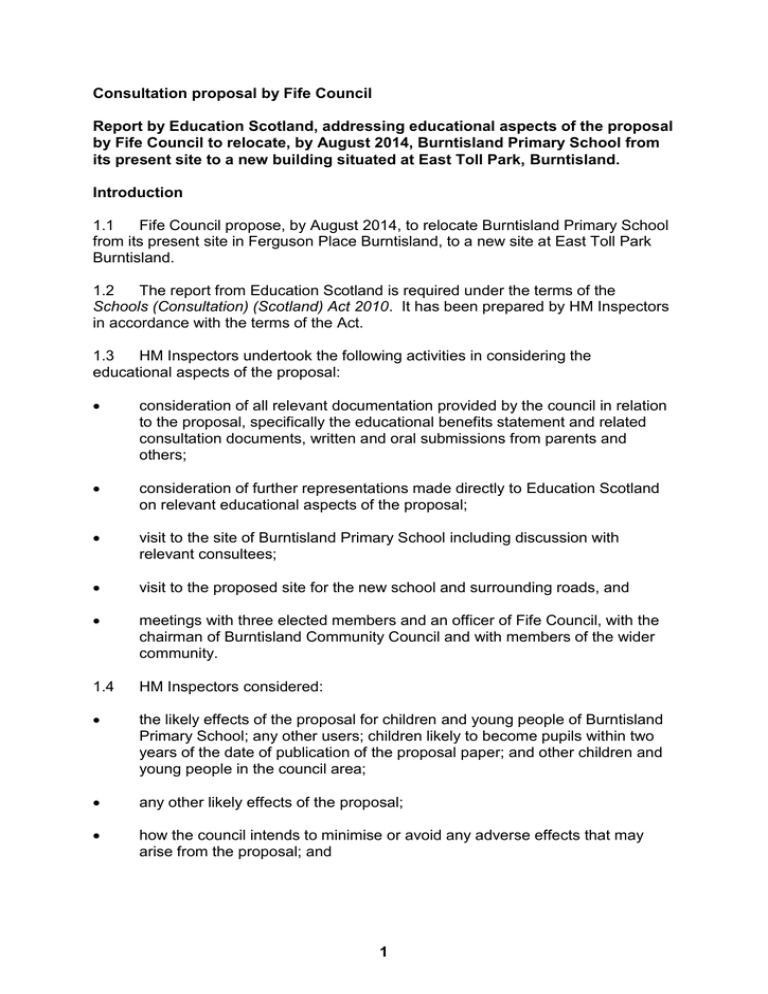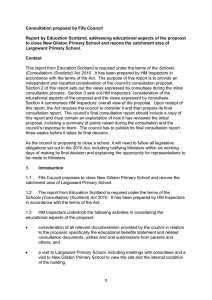Consultation proposal by Fife Council
advertisement

Consultation proposal by Fife Council Report by Education Scotland, addressing educational aspects of the proposal by Fife Council to relocate, by August 2014, Burntisland Primary School from its present site to a new building situated at East Toll Park, Burntisland. Introduction 1.1 Fife Council propose, by August 2014, to relocate Burntisland Primary School from its present site in Ferguson Place Burntisland, to a new site at East Toll Park Burntisland. 1.2 The report from Education Scotland is required under the terms of the Schools (Consultation) (Scotland) Act 2010. It has been prepared by HM Inspectors in accordance with the terms of the Act. 1.3 HM Inspectors undertook the following activities in considering the educational aspects of the proposal: consideration of all relevant documentation provided by the council in relation to the proposal, specifically the educational benefits statement and related consultation documents, written and oral submissions from parents and others; consideration of further representations made directly to Education Scotland on relevant educational aspects of the proposal; visit to the site of Burntisland Primary School including discussion with relevant consultees; visit to the proposed site for the new school and surrounding roads, and meetings with three elected members and an officer of Fife Council, with the chairman of Burntisland Community Council and with members of the wider community. 1.4 HM Inspectors considered: the likely effects of the proposal for children and young people of Burntisland Primary School; any other users; children likely to become pupils within two years of the date of publication of the proposal paper; and other children and young people in the council area; any other likely effects of the proposal; how the council intends to minimise or avoid any adverse effects that may arise from the proposal; and 1 benefits which the council believes will result from implementation of the proposal, and the council’s reasons for coming to these beliefs. 2. Consultation process 2.1 Fife Council undertook the initial consultation on its proposals with reference to the Schools (Consultation) (Scotland) Act 2010. 2.2 The council has, over a number of years, undertaken a process of public engagement and consultation on the future of Burntisland Primary School. The process has involved consideration of several options including extensive refurbishment of the existing building and the construction of a new school building elsewhere in the town. In June 2010, stakeholders and council officers made site visits to a number of potential locations for a new school building. Further public engagement on six possible sites took place in June and September 2010. Subsequently a cross-service group of officers examined comments on the six sites and scored each one against 10 criteria. The process led council officers to conclude that a site at East Toll Park would be the most suitable option. In November 2010, Fife Council Education and Children’s Services Committee endorsed the view that, if a new build option was to be considered for Burntisland Primary School, it should be located at East Toll Park. In addition, the committee asked for the preparation of three business cases to cover the new build option, redevelopment of the existing site and buildings and the maintenance of the existing buildings in a wind and watertight condition. In May 2011, the committee considered the business cases and decided to progress plans for a new building at East Toll Park. In September 2011, the committee decided to go out to formal consultation on its proposal to relocate Burntisland Primary School to a new building at East Toll Park. 2.3 The council has taken a number of steps to consult with stakeholders. The proposal document was widely circulated to parents and carers of nursery and primary children attending Burntisland Primary School, to the Parent Council, to the headteacher and staff of the school, to partner providers and organisers of pre–five education and playgroups and to Burntisland Community Council. The document was made available on the council’s website. The council arranged for posters to be displayed in public places and also placed an advertisement in the local newspaper. The council established a representative school liaison group in June 2011. The group’s remit included providing communication and cascading information to stakeholders. At the time of the visit by HM Inspectors the group had met on three occasions with a further meeting scheduled to take place in the very near future. In September 2011, the council sought to fulfil its responsibility to call a public meeting through six drop-in sessions at which members of the public could examine the proposal and engage with officers of the council. A total of 137 people attended these sessions. The council did not arrange a formal public meeting that would have brought together stakeholders and other interested parties in larger numbers. In October 2011, a well–attended public meeting was convened by the Community Council. Officers of Fife Council attended and participated in that meeting. The council provided paper and electronic versions of a response form that could be used by stakeholders and others to indicate whether or not they supported the council’s proposal. The council received 848 responses. The council’s analysis of 2 the responses indicated strong support for the proposal amongst parents and carers and amongst a group classified as other interested parties. A majority of those classified as local residents were against the proposal. 2.4 Perceptions of the efficacy of the council’s consultation process have been very variable. Parents, as represented by the Parent Council, felt they had been very well informed and consulted effectively. School staff and children attending the school felt that they have had opportunities to find out more about the proposal and to express their views. However, there is strong feeling within sections of the wider community that all views have not been taken equally and fully into account. That applies particularly to the proposed location for the new school building at East Toll Park. In December 2010, the chairman of the Community Council wrote to the council expressing disquiet about the consultation process. At the public meeting convened by the Community Council in October 2011 there was strong criticism of the consultation process. 2.5 Parents and carers generally felt that they had been well informed and consulted. The council’s form to respond to the proposal was used by 316 parents and carers. The Parent Council had been particularly active in liaising with council officers and in requesting information. Council officers had regularly attended meetings to provide parents with updates on progress. A sizeable majority of parents who responded to the council’s consultation exercise were strongly supportive of the proposal. Almost all agreed that the present building is inadequate and that a replacement is urgently required. Some parents who supported the East Toll Park location expressed concerns about traffic management issues particularly at the start and end of the school day. Some parents who did not support the East Toll Park site expressed similar concerns. 2.6 The council had consulted with some children in the upper stages. However the coverage was uneven. The council’s data indicates 52 responses from children but it is unclear whether these were collective responses, for example from whole classes, or from individual children. Almost all of the children whose responses were recorded favoured the East Toll Park option. Members of the pupil council who met with HM Inspectors were very clear about the limitations of the present building and how if affected their learning. Almost all were in favour of the East Toll Park site. 2.7 The council had not consulted staff as a group. However teachers who met with HM Inspectors felt that there had been adequate opportunity to find out about the proposal and to express their views. Almost all had taken advantage of the council’s drop-in session that had taken place in the school. A few had attended the public meeting arranged by the Community Council in October 2011. All staff who met with HM Inspectors shared children’s perceptions of the limitations of the present building and stressed the need for an urgent resolution. Almost all favoured the proposed site. 2.8 Members of the wider community generally agreed that there is a pressing need to provide improved educational and recreational facilities for children attending Burntisland Primary School. Some members of the wider community supported the council’s proposal. However, a narrow majority who responded formally to the council’s consultation exercise were opposed to the proposal. Many felt they had not 3 been consulted fully on the proposed site at East Toll Park. Some felt that other stakeholder groups have had more information and greater opportunity to express opinions. Some expressed concern about the relatively closed consultation question that asked stakeholders simply if they supported or did not support the proposal to build a new school on East Toll Park. Some questioned the transparency and robustness of the process and the council’s analysis of the responses. Many respondents felt that other options, including alternative sites in the town, had not been explored fully. Some questioned the scoring system that the council had used to identify East Toll Park as the best option. An alternative scoring system used by the Community Council had identified other sites as better options. A great many of those who opposed the council’s proposal regretted the potential loss of green space and amenity which, they argued, is enjoyed and used by the wider community. Others felt that the building of a school on the East Toll Park would add significantly to the already heavy traffic in the area. 3. Educational aspects of the proposal 3.1 The proposal by Fife Council to replace the existing Burntisland Primary School with a purpose-built modern facility would offer significant educational benefits for current and future pupils. There is general consensus amongst all stakeholder groups that there is a pressing need for improved educational facilities for current and future pupils of the school. The council’s proposal accurately describes the limitations of the existing buildings and the educational benefits for children arising from a modern facility. 3.2 At the time of the visit by HM Inspectors, the school had a roll of 472 with a further 140 children attending the nursery for half day sessions. The school roll is projected to rise to 514 in August 2012. The projected increase will place significant additional pressure on existing accommodation. While children continue to learn and achieve well, their educational experience is constrained by the present buildings. The very positive report on the work of the school, published by HM Inspectorate of Education in June 2010, makes reference to a number of issues with regard to accommodation and accessibility. The council’s estates condition survey rated the existing buildings as “C” (poor) for condition and “D” (bad) for both suitability and accessibility. Children and staff frequently have to move between buildings in inclement weather. Classrooms of differing size and suitability make it difficult to place same stage classes together. Very young children have to negotiate steep external and internal stairs to access their classrooms. In parts of the school, toilets are situated some distance from classrooms. A single area serves as gymnasium and dining room. This makes it difficult for the school to provide children with the expected amount of quality physical education. To do so, the school makes use of other facilities including the East Toll Park. Space for meetings and performances is severely limited. The nature of the building and its classrooms restricts access to information and communications technology (ICT) equipment. Children who met with HM Inspectors made very justified complaints about the severe shortage of playground space and areas where they could socialise. The acute shortage of space restricts opportunities for outdoor learning. The building does not conform to the terms of the Disability Discrimination Act. More playground space has been lost recently through the installation of a temporary classroom to accommodate a child 4 with significant mobility difficulties. There are concerns about the security of children and staff arising from very regular movement between buildings. 3.3 The council proposes to build a new school on East Toll Park which is situated very close to the existing building. Plans for the proposed new build are at an indicative stage and it is not possible to comment on the proposal in detail. However, the indicative plans suggest that the council’s proposal would offer significant educational benefits for current and future pupils of Burntisland Primary School. Children in the nursery and at the primary stages would be accommodated in a single building. Children would no longer be exposed to the weather as they move from area to area within the school. The proposed “hub” building is likely to improve children’s experiences and learning through dedicated areas for physical education, dining and socialising. ICT provision would be improved and be more accessible. A modern, purpose built facility would provide greater flexibility for children to learn and develop. Children would benefit greatly from a significant increase in outdoor play space including access to the adjacent all weather surface and improved football pitch. The increased amount of open space around the school would provide children and staff with greater opportunity for outdoor learning. A new building would be accessible for children and other users experiencing mobility difficulties. 3.4 Many respondents to the council’s consultation expressed concern about the impact on traffic and road safety should the proposed school be situated at East Toll Park. The council’s preferred site lies adjacent to a very busy roundabout. It is possible that the proposal would create additional traffic, particularly at the start and finish of the school day. Consultees have reasonable concerns about road safety issues arising from the council’s proposal. 3.5 East Toll Park would provide a sufficiently large space for the proposed building and for outdoor recreation and learning areas for children. The council recognises that there is considerable local opposition to its proposal. Many of those opposing the proposal favour the retention of what they believe to be an important green space and the public amenity it provides. The council’s concept plan attempts to address some of those concerns through locating the proposed building towards the south east of the park. In taking forward its detailed proposal, the council needs to continue to fully engage with all stakeholders including community groups, to ensure that the benefits for children and the wider community are understood and maximised. 4 Summary There is widespread agreement within the town of Burntisland that a modern school building would be of considerable educational benefit to children and the wider community. Improved facilities would do much to address the very significant limitations imposed by the existing buildings. There is a pressing need for more and better quality accommodation to allow children to continue to learn and achieve well. While there is general agreement on the need for an improved facility, there are sharp divisions within the community about the council’s preferred location for the 5 proposed school. The council’s proposal offers significant educational benefits for children. However, some sections of the local community feel that the council has not effectively engaged and consulted with them. In particular they feel that the potential of other options, including other sites, has not been explored fully. Many of those who oppose the council’s preferred site make particular reference to traffic management issues and the loss of an open space that is used and valued by the local community. The council recognises that its proposal has created strong feelings of support and opposition within the local community. The council believes that none of the proposed sites are ideal, but is of the opinion that the East Toll Park site is the most suitable option. It has taken steps to address some of the community’s concerns about traffic management, loss of green space and loss of public amenity. In taking forward its proposal the council needs to prepare detailed plans that demonstrate further the educational benefits of its proposal and how it intends to address the reservations expressed by sections of the community. It needs to ensure that all sections of the community perceive that they have been fully engaged in the next stages of the process. HM Inspectors Education Scotland November 2011 6




